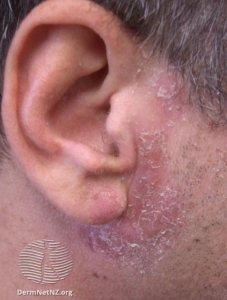Airborne contact dermatitis
Airborne contact dermatitis refers to acute and chronic dermatitis of exposed parts of the body, especially the face, caused by particles suspended in the air. These particles may include fibers, dust, vapors, sprays, gasses, and plant materials.Airborne contact dermatitis can affect anyone; it is seen commonly in occupations associated with exposure to known allergens.
Clinical presentation
The distribution of airborne contact dermatitis is usually symmetrical. The exposed areas are most commonly affected, including the face, dorsal hands, neck, upper chest, and forearms.
Eyelid contact dermatitis is common and can be the only affected site.Occasionally, covered areas can also be affected due to the accumulation of airborne particles under the garments.Common symptoms of airborne contact dermatitis include itching, burning, and stinging.
Airborne contact dermatitis usually presents with diffuse scaly erythematous macules but plaques may also occur. Sometimes a pustular rash can occur as a result of secondary bacterial infection
Diagnosis
The diagnosis of airborne contact dermatitis can be difficult. The diagnosis relies on taking a comprehensive clinical history, the timeline of the symptoms, consideration of occupational and non-occupational exposures, and finding the characteristic distribution and morphology of the rash on physical examination.Tests that can be considered are patch test & photopatch test.
DDx
There are many differential diagnoses to consider and airborne contact dermatitis should be distinguished from the following; Non-airborne irritant contact dermatitis and allergic contact dermatitis, Non-airborne photocontact dermatitis, Systemic contact dermatitis and Ectopic contact dermatitis.
Treatment & Management
The treatment for airborne contact dermatitis depends on the specific cause. After identifying the specific substance causing airborne contact dermatitis, every effort should be made to reduce the exposure to it. A change of job or residence is sometimes necessary to reduce exposure.
Other measures include Emollients and topical corticosteroids.For severe cases treatment can include Systemic steroids, Azathioprine, Mycophenolate, Methotrexate and Cyclosporine.
Prognosis
Airborne contact dermatitis can have a significant impact on patients’ quality of life. Complete recovery can often be achieved with avoidance of further exposure, but in severe cases such as Parthenium dermatitis, immunosuppression is often required . Some patients may progress to chronic actinic dermatitis
Written by: Khalid Nagshabandi, medical student
References:
DermNet
Open dermatology journal

